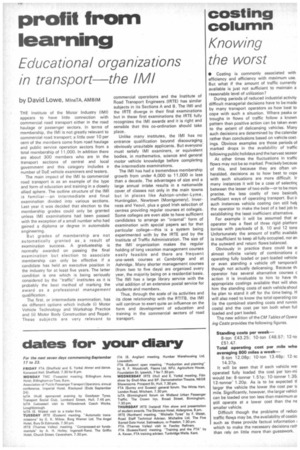profit from learning
Page 80

If you've noticed an error in this article please click here to report it so we can fix it.
Educational organizations in transport the IMI
by David Lowe, MInsTA, AMBIM
THE Institute of the Motor Industry 11M1) appears to have little connection with commercial road transport either in the road haulage or passenger sectors. In terms of membership, the IMI is not greatly relevant to commercial road transport; a little over 10 per cent of the members come from road haulage and public service operation sectors from a total membership of 11,000. In addition there are about 300 members who are in the transport sections of central and local government and this category includes a number of DoE vehicle examiners and testers.
The main impact of the IMl to commercial road transport is as an example of the type and form of education and training in a closely allied sphere. The outline structure of the IMI is familiar--an intermediate and final examination divided into various sections. Last year it was decided that election to the membership grades could only be granted unless IMI examinations had been passed with the exception of a small number who had gained a diploma or degree in automobile engineering.
But grades of membership are not automatically granted as. a result of examination success. A graduateship is normally awarded on passing the final examination but election to associate membership can only be effective if a candidate has held an executive position in the industry for at least five years. The latter condition is one which is being seriously considered by the -traffic" institutes as it is probably the best method of marking the award as a professional management qualification.
The first, or intermediate examination, has six different options which include (i) Motor Vehicle Technology and Workshop Practice and {ill Motor Body Construction and Repair. These subjects are very relevant to commercial operations and the Institute of Road Transport Engineers (IRTE) has similar subjects in its Sections A and B. The IMI and the IRTE diverge in their final examinations but in these first examinations the IRTE fully recognizes the 111/11 awards and it is right and sensible that this co-ordination should take place.
Unlike many institutes, the IMI has no entrance qualification beyond discouraging obviously unsuitable applicants. But everyone. must satisfy IMI examiners, or equivalent bodies, in mathematics, science and general motor vehicle knowledge before completing the intermediate examinations.
The IMI has had a tremendous membership growth from under 4,000 to 11,000 in less than a decade. The advantages of size and a large annual intake results in a nationwide cover. of classes not only in the main towns but in places like Ashton-under-Lyme, Huntingdon, Newtown (Montgomery), Inverness and Yeovil, plus a good Irish selection of centres providing regular courses at colleges. Some colleges are even able to have sufficient candidates to arrange an "internal" form of examination with special papers set for that particular college—this is a system being experimented with by the IRTE and by the Institute of Traffic Administration. The size of the IMI organization makes the regular holding of long vacation management courses easily feasible and there are frequent one-week courses at Cambridge and at Ashridge. Many shorter management courses (from two to five days) are organized every year, the majority being on a residential basis. The IMI has a large library service with the vital addition of an extensive postal service for students and members.
Thus, through the scale of its activities and its close relationship with the RTITB, the IMI will continue to exert quite an influence on the form and development of education and training in the commercial sectors of road transport.




















































































































